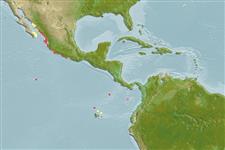>
Blenniiformes (Blennies) >
Tripterygiidae (Triplefin blennies) > Tripterygiinae
Etymology: Axoclinus: Greek, axis = axis + Greek, klinein = sloping and bed, due to the four apophyses of sphenoid bone.
Environment: milieu / climate zone / depth range / distribution range
Ecología
marino demersal; rango de profundidad 7 - 8 m (Ref. 46206). Tropical
Eastern Central Pacific: Isla del Coco. A very similar but possibly undescribed species from the Revillagigedo Islands.
Tamaño / Peso / Age
Maturity: Lm ? range ? - ? cm
Max length : 3.5 cm TL macho / no sexado; (Ref. 11482)
Short description
Claves de identificación | Morfología | Morfometría
Espinas dorsales (total) : 16; Radios blandos dorsales (total) : 9; Espinas anales: 2; Radios blandos anales: 18. Lateral line gradually descending from upper edge of gill cover to midlateral axis; lateral line with 21-26 tubed scales followed by 8-12 notched scales; total scales in longitudinal series 33-35; a small lanceolate cirrus on upper edge of eye. Head pink to reddish; side with 3 broad, dark brown bars with narrow, whitish spaces between them; a black band around base of caudal fin; caudal fin frequently black (Ref. 11482).
Adults inhabit shallow rocky areas. They feed on tiny invertebrates and algae (Ref. 11482). Eggs are hemispherical and covered with numerous sticky threads that anchor them in the algae on the nesting sites (Ref. 240). Larvae are planktonic which occur primarily in shallow, nearshore waters (Ref. 94114).
Life cycle and mating behavior
Madurez | Reproducción | Puesta | Huevos | Fecundidad | Larva
Fricke, R., 1997. Tripterygiid fishes of the western and central Pacific, with descriptions of 15 new species, including an annotated checklist of world Tripterygiidae (Teleostei). Theses Zool. 29:1-607. (Ref. 27223)
IUCN Red List Status (Ref. 130435: Version 2024-2)
Threat to humans
Harmless
Human uses
Herramientas
Special reports
Download XML
Fuentes de Internet
Estimates based on models
Preferred temperature (Ref.
123201): 24.8 - 29.1, mean 28 °C (based on 105 cells).
Phylogenetic diversity index (Ref.
82804): PD
50 = 0.5156 [Uniqueness, from 0.5 = low to 2.0 = high].
Bayesian length-weight: a=0.00617 (0.00288 - 0.01322), b=3.04 (2.86 - 3.22), in cm total length, based on LWR estimates for this (Sub)family-body shape (Ref.
93245).
Nivel trófico (Ref.
69278): 2.8 ±0.26 se; based on food items.
Resiliencia (Ref.
120179): Alto, población duplicada en un tiempo mínimo inferior a 15 meses (Preliminary K or Fecundity.).
Fishing Vulnerability (Ref.
59153): Low vulnerability (10 of 100).
